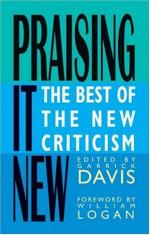|
This section contains 5,619 words (approx. 19 pages at 300 words per page) |

|
SOURCE: Perl, Jeffrey M. “Passing the Time: Modernism versus New Criticism.” In The Future of Modernism, Hugh Witemeyer, pp. 33-48. Ann Arbor: University of Michigan Press, 1997.
In the following essay, Perl studies the relationship between modernism and New Criticism, focusing on the use of these theories by academic institutions in both England and the United States.
If modernism—“palaeomodernism” in Frank Kermode's vocabulary, “The Pound Era” in Hugh Kenner's, “The Kenner Canon” in Carolyn Heilbrun's—is to have a future, it will need to be freed from the embrace of loved ones. The New Critics portrayed themselves as friends of the aesthetics and critical theory established by Eliot, Joyce, and Pound; it was thus natural that, when the overdue rebellion against New Critical orthodoxy occurred, academic opinion would turn against modernism. Yet the New Critical reading of modernism was impossibly wrong. Eliot, who appears as founder of New...
|
This section contains 5,619 words (approx. 19 pages at 300 words per page) |

|


